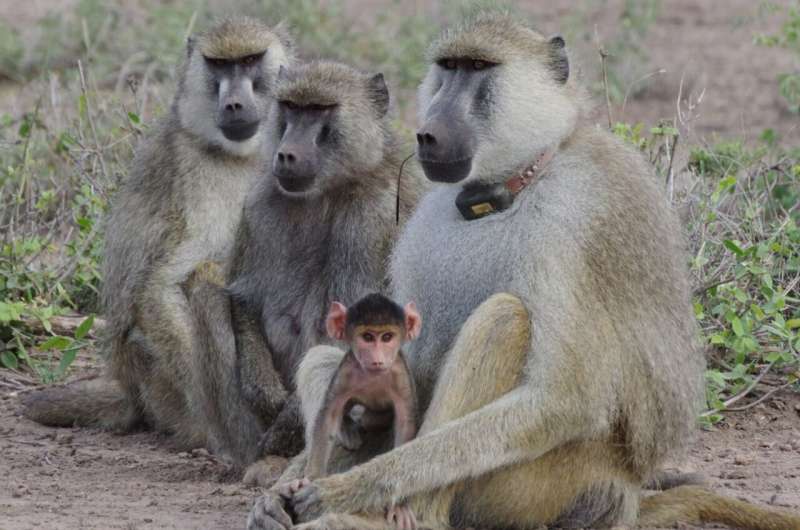In a groundbreaking study published on July 5, 2025, researchers from the University of Notre Dame have uncovered a significant link between father-daughter relationships and the longevity of female baboons. The findings, published in the Proceedings of the Royal Society B, suggest that strong paternal bonds in early life can lead to longer lifespans for female baboons.
While paternal care is rare among mammals, the study highlights how father-daughter interactions can have profound effects on survival rates. The research, conducted in the Amboseli ecosystem of East Africa, evaluated the social dynamics of 216 female baboons and their fathers. It was found that daughters who maintained close bonds with their fathers, either through co-residence or interaction, lived two to four years longer than those with weaker paternal ties.
Exploring the Role of Fathers in Baboon Society
Traditionally, baboon mothers are the primary caregivers, providing essential care to their offspring. However, this study sheds light on the previously underestimated role of fathers. According to Elizabeth Archie, a professor of biological sciences at Notre Dame and the study’s corresponding author, male baboons transition into a ‘dad mode’ as they age, investing more time in their offspring as their reproductive success declines.
“Male baboons tend to reach their peak reproductive success when they’re young adults,” Archie explained. “Once they’ve had a few kids and their condition declines, they sort of slide into ‘dad mode,’ where they don’t disperse as much and they don’t try as hard to mate. Then they have time to invest in and hang out with their kids.”
Key Findings and Implications
The research team discovered that about one-third of the daughters lived in the same social group as their fathers for three years or more. This co-residence was linked to stronger grooming relationships, a key indicator of social bonding and hygiene in baboons. Grooming, as Archie describes, is akin to “the human equivalent of sitting down, having a cup of coffee and a good chat.”
“Early life adversity has a powerful effect on lifespan, so this study suggests that having a dad allows females that have experienced other forms of adversity to recover some of those costs,” Archie said.
The study also found that strong relationships between juvenile females and other adult males did not predict increased survival, underscoring the unique impact of paternal bonds. Male baboons often intervene in conflicts, providing protection to their daughters and expanding their social networks.
Broader Implications for Evolutionary Biology
This research not only offers insights into baboon social structures but also hints at the evolutionary roots of human parental care. Despite the minimal contributions of mammal fathers in general, the study suggests that even minor paternal involvement can have significant consequences.
The study is part of the long-running Amboseli Baboon Research Project, which began in 1971. Co-directed by Archie, Susan Alberts from Duke University, and Jenny Tung at the Max Planck Institute for Evolutionary Anthropology, the project continues to provide valuable data on primate behavior and social dynamics.
According to Archie, “Males seem to sort of expand a child’s social network, as they can be popular members of their social group. Lots of baboons are coming up and interacting with the male. So an infant who’s hanging out near a male has more diverse social interactions than if they’re only hanging out with mom.”
Future Research Directions
The findings open new avenues for research into the role of paternal care in other species and its evolutionary significance. As the Amboseli Baboon Research Project continues, further studies may explore how these dynamics influence other aspects of baboon life and contribute to our understanding of social evolution in primates.
In conclusion, the study highlights the importance of paternal relationships in the animal kingdom, challenging previous assumptions about the limited role of fathers in mammal societies. As researchers delve deeper into these dynamics, the implications for understanding both animal and human social structures could be profound.
 Moon Phases Explained: What to Expect on July 6, 2025
Moon Phases Explained: What to Expect on July 6, 2025 Moon Phases Explained: July 6, 2025 Waxing Gibbous Illuminates the Night Sky
Moon Phases Explained: July 6, 2025 Waxing Gibbous Illuminates the Night Sky Mysterious Skull Formation on Canadian Coast Sparks Alien Theories
Mysterious Skull Formation on Canadian Coast Sparks Alien Theories Why Satellites Use ‘Gold Foil’ for Thermal Protection in Space
Why Satellites Use ‘Gold Foil’ for Thermal Protection in Space World’s First Anti-Sickness Car Promises a Smoother Ride for Motion-Sensitive Drivers
World’s First Anti-Sickness Car Promises a Smoother Ride for Motion-Sensitive Drivers